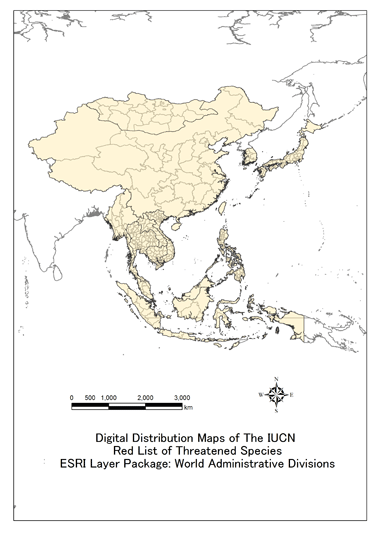
TOP > 生物多様性センターの国際協力 > ESABII > Database > Threatened Mammal Species Database > Tarsius sangirensis

Tarsius sangirensis
Taxonomy (Name)
| Class | MAMMALIAIUCN | |
|---|---|---|
| Order | DIPROTODONTIAIUCN | |
| Family | TARSIIDAEIUCN | |
| Scientific Name | Tarsius sangirensisIUCN | |
| Author | Meyer, 1897IUCN | |
| Synonyms | ||
| Common Name | Sangihe Tarsier, Sagihe Island TarsierIUCN | |
| Local name | Brunei Darussalam | |
| Cambodia | ||
| China | ||
| Indonesia | Binatang hantu, Singapuar (semua jenis dari genusTarsius) | |
| Japan | ||
| Lao PDR | ||
| Malaysia | ||
| Myanmar | ||
| Mongolia | ||
| Philippines | ||
| Singapore | ||
| Republic of Korea | ||
| Thailand | ||
| Vietnam | ||
Picture
Distribution, Range
This species is currently recorded as being found on Sangihe island, north of Sulawesi, Indonesia (Riley 2002).
Map


Country
| Brunei Darussalam | |
|---|---|
| Cambodia | |
| China | |
| Indonesia | |
| Japan | |
| Lao PDR | |
| Malaysia | |
| Myanmar | |
| Mongolia | |
| Philippines | |
| Singapore | |
| Republic of Korea | |
| Thailand | |
| Vietnam |
Status
International Status
IUCN Red List Category
ENIUCN
Justification
The species is considered Endangered; however, this assessment will need to be revisited once the species is separated into two species. The species' extent of occurrence is approximately 700 km2 and it is in continued decline of area of occupancy and available habitat.
CITES
Appendix II
CMS
National Status
| Country | Category | Reference |
|---|---|---|
| Brunei Darussalam | ||
| Cambodia | ||
| China | ||
| Indonesia | ||
| Japan | ||
| Korea | ||
| Lao PDR | ||
| Malaysia | ||
| Mongolia | ||
| Myanmar | ||
| Philippines | ||
| Singapore | ||
| Thailand | ||
| Vietnam |
Ecology Discription
Appearance
Habitat
This population has not been studied systematically in the wild, but was surveyed by M. Shekelle and associates (Shekelle et al. 1997; Shekelle 2003), and Riley (2002). Riley remarked that T. sangirensis has a preference for primary forest, but may occur in secondary habitats including sago swamps, scrub, nutmeg plantations, coconut plantations, and secondary forest growth. These results are similar to those of Shekelle and associates, except that Shekelle did not encounter any tarsiers in primary forest.
Population size
M. Shekelle and A. Salim (pers. comm.) estimate the population size to be between 1,505 and 52,734 individuals, the very wide range being a result of uncertainty in the suitability of "brush" habitat for sustainable tarsier populations. Without including "brush," the population size estimate is only 1,505-2,795 individuals. Riley (2002) estimated population size as 9,000-15,600, but those numbers drop to 300-500 if secondary habitat is excluded. Riley did not address the issue that, while tarsiers are recorded in secondary habitats, these might not support sustainable populations. Thus, the conclusions of both studies are similar; viable population size might be very small indeed, unless populations in suboptimal habitats are "sources" and not "sinks."
Behavior
Diet
Reproduction
Threat
Major Threat(s)
M. Shekelle and A. Salim (pers. comm.) argue that the chief threat to tarsiers on Sangihe Island is habitat loss, while Riley (2002) did not think that habitat loss was a major threat, given their presence in a variety of secondary habitats. This discrepancy once again points out the need to determine the suitability of secondary habitats for sustainable tarsier populations.
Conservation and Measurement
International
Appendix II
National
The taxon has been protected by national law since 1931, and is listed as CITES Appendix II. Two conservation initiatives begun in 2002 are serving to establish management systems on this archipelago and to educate its people on the environmental and conservation problems the islands face, including forest management and hunting issues (Riley 2002).
Conservation law
| Country | Status | Reference |
|---|---|---|
| Brunei Darussalam | ||
| Cambodia | ||
| China | ||
| Indonesia | Protected Animals(as Tarsius spp.) | Goverment Regulation no. 7 / 1999, about Preservation of Plants and Animals |
| Japan | ||
| Korea | ||
| Lao PDR | ||
| Malaysia | ||
| Mongolia | ||
| Myanmar | ||
| Philippines | ||
| Singapore | ||
| Thailand | ||
| Vietnam |
Protected Area
Other Coservation Projects
Citation
Groves, C. P. 2001. Primate taxonomy. Smithsonian Institution Press, Washington, DC, USA.
IUCN. 2008. 2008 IUCN Red List of Threatened Species. Available at: http://www.iucnredlist.org. (Accessed: 5 October 2008).
Riley, J. 2002. Mammals on the Sangihe and Talaud Islands, Indonesia, and the impact of hunting and habitat loss. Oryx 36(3): 288?296.
Shekelle, M. 2003. Taxonomy and Biogeography of Eastern Tarsiers. Doctoral Thesis, Washington University.
Shekelle, M. and Salim, A. 2009. An acute conservation threat to two tarsier species in the Sangihe Island chain, North Sulawesi, Indonesia. Oryx 43: 419-426.
Shekelle, M., Leksono, S. M., Ichwan, L. L. S. and Masala, Y. 1997. The natural history of the tarsiers of North and central Sulawesi. Sulawesi Primate Newsletter 4(2): 4-11.
